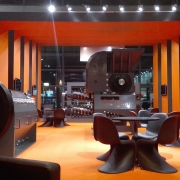Processing of Electric Motors and Copper “Meatballs”
German-based company Sicon – specialized in the development of systems related to scrap processing and metal separation – explains how new equipment solutions allow for a flexible system that can easily adapt to changing market conditions.
The main component of a shredder downstream is a hand-picking-station to ensure complete removal of copper-containing materials from scrap. Hand-pickers, depending on the efficiency of the individual ones, are usually able to remove 0.5-0.8 percent copper from shredder scrap.
Modern shredder operations facilitate and optimize handpicking with cutting-edge equipment. One such machine is Sicon’s PrimeScrap. The PrimeScrap separates the shredded scrap into two fractions based on ballistic and magnetic properties of the material. With this approach, 70-80 percent of the material flow is clear of any copper-containing materials or material-compounds and can be directly discharged without further handpicking. The remaining 20-30 percent can now be better distributed on the conveyor belt and presented to the hand-pickers, making the handpicking task leaner and more efficient as the workers now have less material to process.
Until recently, the recovered copper meatballs have been mainly exported as local demand for these without further processing was non-existing. Current Chinese restrictions on imports have influenced national markets in recent months as increasingly marketing the copper meatballs becomes more difficult. Although they do not necessarily mean that China will no longer import scrap metal, the export to China becomes increasingly difficult and pressure on pricing is already notable.
Consequently, more scrap and metal-processing companies are entering the market for non-ferrous recovery from copper meatballs and electric motors. These processing companies supply the recovered metals as raw material directly to smelters. In most cases, this practice has become more lucrative than exporting the non-ferrous metals. The increased added-value within the company guarantees a long-term marketing success with generated non-ferrous material and helps to establish direct customer contact which often leads to new business opportunities.
Flexible solutions with a modular concept
The main requirement for economical processing of meatballs and electric motors is a system’s flexibility. Often copper meatballs cannot be sourced in sufficient quantities to justify a large investment. However, there are multiple other materials that can be processed with the same equipment for further recovery. Driven by the demand for a flexible and versatile solution, Sicon has developed the EcoShred Vertec and has already installed multiple units successfully.
Many mixed-metal fractions can be introduced to the EcoShred Vertec as input:
■ Copper Meatballs
■ Electric motors
■ Transformers
■ Radiators
■ (ASR = Automotive Shredder Residue) Mixed cables & Insulated Copper Wire (ICW)
■ Household Appliance
■ Irony Aluminum
Economically-viable processing requires the right equipment and a knowledgeable partner who has the system-understanding to build and configure a process to customer-specific needs. Each customer has individual requirements, which have to be met to ensure a successful investment.
Some of these specification requirements are:
■ Equipment and system as a whole must be flexible to cope with various input materials,
■ quality of end products must meet exact end-buyer specifications without exception,
■ processing- and operating costs must be low in order to cope with market fluctuations and continue to be profitable,
■ equipment must be heavy-duty built and remain robust throughout its entire life cycle; the partner company’s offered repair and maintenance service ensures equipment availability at all times,
■ automatization warrants continuous transparency, both technically as well as economically.
With all of today’s demands towards electric motors and meatball processing, Sicon meets all with its flexible solutions with a modular concept. First, the above-described EcoShred Vertec, available in four different performance configurations ranging from 90 up to 464 kW (kilowatt) or 120 HP and 620 HP (horsepower) retrospectively, liberates the material. By Sicon’s account, the Vertec tools have been specifically designed for maximum smooth liberation. The gentle size-reduction is especially important for recovered aluminum from electric motors as it is required to be as large as possible. The following refining modules include the EddyPro eddy current as well as the EcoShred Imtec balling mill. Additional steps in the refining process include density-based separation which yields metallurgical clean copper and aluminum grain. A separate module is available for initial cable processing and refining with the above-described processing steps. Sicon’s approach with the presented equipment solutions allows for a highly-flexible system that can easily adapt to changing market conditions.
“We at Sicon provide support to our customers from the initial idea throughout the individualized development and design phase up to the realization and start-up of equipment”, the company underlines. “After a project, our sales engineers continue to provide support on scrap and metal processing matters.”
https://sicontechnology.com/en/
Photo: Sicon
GR 2/2018









